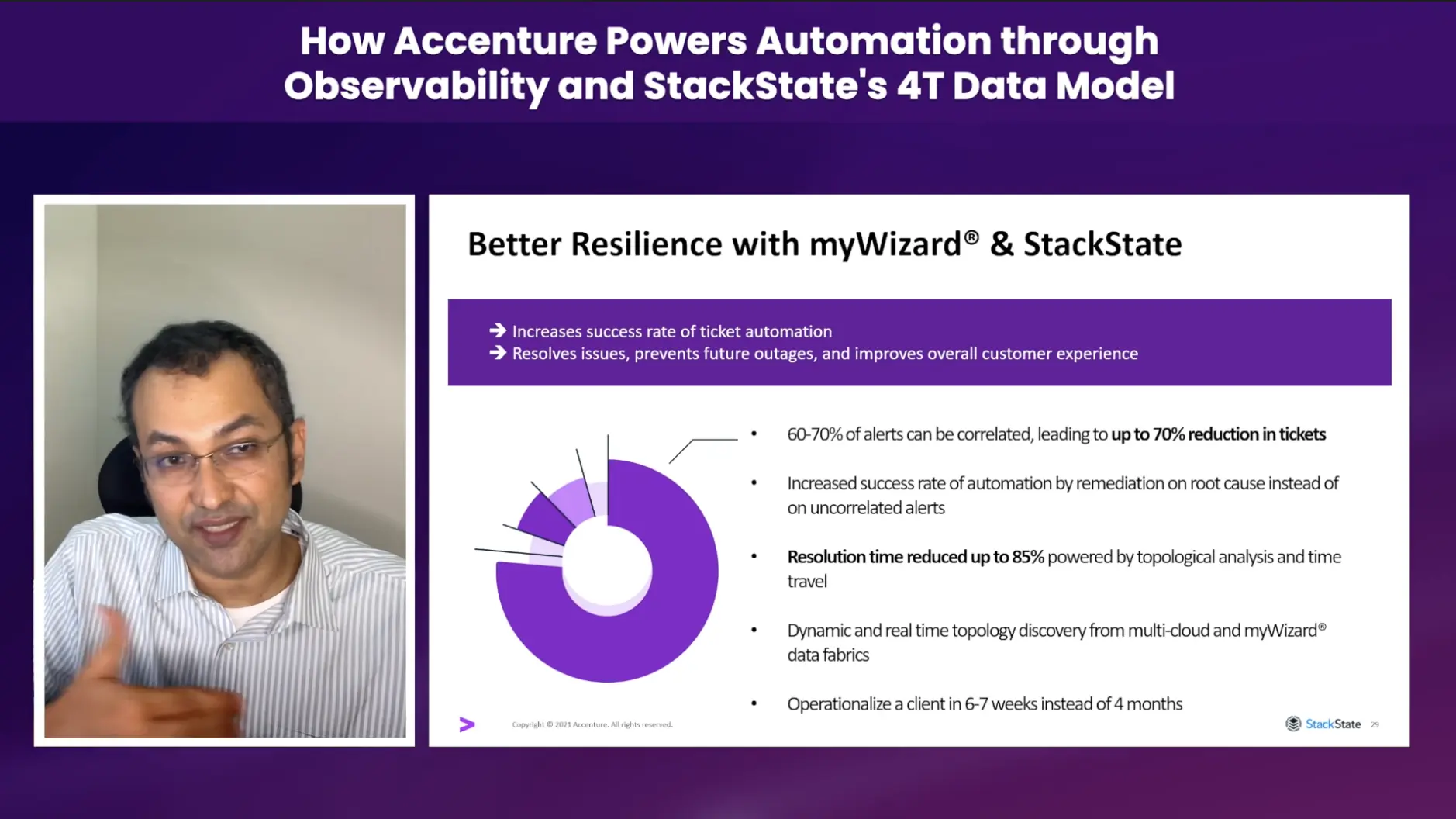At the recent Gartner IT Infrastructure, Operations and Cloud Strategies conference, Accenture’s Luke Higgins and Koushik Vijayaraghavan gave a 20-minute talk highlighting the company’s innovative AIOps-based approach to continuous improvement for their customers.
Accenture is a Tier 1 multinational professional services company that specializes in IT services and consulting. As a Fortune Global 500 company, it reported revenues of $44.33 billion in 2020 and had 569,000 employees. In the recent talk, “How Accenture Powers Automation Through Observability and StackState’s 4T Data Model,” Accenture personnel outline how they use StackState's advanced 4T Data Model combined with AIOps to:
Automate self-healing capabilities
Achieve up to 70% reduction in tickets
Realize up to 85% reduction in problem resolution time
The Challenge: Noise Reduction and Root Cause Analysis
Accenture utilizes StackState to create an essential foundation to automate ticket resolution for their myWizard® platform. If a problem occurs in myWizard, often numerous alerts go off across multiple disparate systems, making it difficult to determine the root cause. But without accurately pinpointing the initial problem, it’s impossible to implement self-healing procedures and automate problem resolution. In fact, if an automated process tries to fix the wrong root cause, it can break the system further – so it’s essential to know the initial, parent cause of a problem.
StackState’s unique platform correlates the 4Ts of observability – Topology, Telemetry and Traces over Time – across Accenture’s multiple disparate systems, showing exactly what happened and what an entire stack looked like at any moment in time. Instant and accurate root cause analysis helps Accenture automate and accelerate problem remediation and Autonomous Anomaly Detection helps them reduce the number of incidents altogether, using StackState’s zero-configuration AIOps capabilities to predict and avoid problems.
Talk Highlights
Luke Higgins, Managing Director, Accenture

“We are getting inputs from StackState to be able to do that automatic discovery for us, but then starting to merge in other topologies that we can get from other sources, and to bring it together into a master topology…really driving the alignment to the digital business-aligned topology as well so that we can understand with the focus top down on those business services, what are the underlying dependencies?
"[StackState] gives us the ability to constantly track what's happening in our constantly changing environments, particularly now, the cloud is evolving so quickly, and we are continuously delivering into those environments.
"[StackState] improves the efficiency of the way we deliver that software as well. And finally, having that observability in combination with the topology gives us that resilience and also an awareness around security to ensure that we exactly understand what the fingerprint of our environment is.
"The 4Ts [StackState’s 4T data model]… represent four key dimensions, actions that I think are game changing, to have together.
"So when we're in these changing environments, we can actually go back to the point in time that those changes occurred within the topology and understand the exact state of the topology. This capability is extremely important when it comes to troubleshooting.
"…And finally, tracing - which is critical, because that data focuses on the customer journey. It gives us the ability to overlay those customer journeys in the combination of those other three dimensions: which steps in the topology does the customer pass through, at what point in time, and how is the actual underlying services and infrastructure performing within our cloud states, as well as what's actually being brought in from our other sources of data like Splunk, or other types of monitoring APM level information we can be collecting."
Koushik Vijayaraghavan, Global Asset Engineering and Architecture Lead, Lead for Intelligent Automation, Agile and DevOps, Accenture India

“With the 4T Data Model being implemented, what this essentially means that you see here, the 100 tickets are now suppressed into 40 unique events, which are well-correlated.
"…The speed at which we have been able to operationalize this with clients is significantly increased as well. We are able to do this now in weeks, rather than months.”

Luke’s Summary
"We are really relying upon StackState to be able to pull [data] together and merge these various topologies from different sources and systems of record: cloud, you know, discovered components and bring them together. So we can correlate in a smart way what's actually going on inside the system, but also trap it in a slice of time, so that at any point in time, we can see what changes are occurring in these dynamic systems, so that our automation can go back to those points in time and understand what was the root cause of a problem.
"And this is what is driving an improved customer service delivery. This is what is driving an improved business outcome for our customers. It's also enabling our AI and machine learning to be able to engage in these different dimensions of data to make better decisions and ensure that we deliver a better service for our customers."



